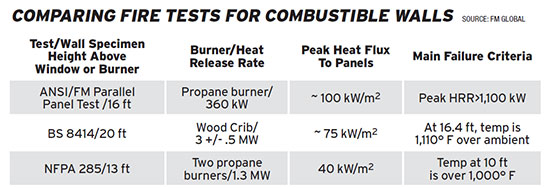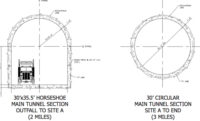After Grenfell Tower
Do Tests For Combustible Exterior Building Walls Match Real-Life Fire Intensity?

Low-rise buildings are not subject to the same codes as high rises, but both burn hotter, with potentially shorter escape time for occupants.
PHOTO CREDIT: JOHN SPINK/ATLANTA JOURNAL-CONSTITUTION VIA AP

FM Global has sought adoption of the ANSI/FM 4880 fire test approval standard, which involves parallel panels exposed to higher levels of heat than in other similar tests. “Not all fire tests used for exterior wall assemblies use a severe enough ignition source or the correct geometry to represent actual fire conditions,” the company argued in a brochure. The insurer’s certification unit tested assemblies constructed with various types of aluminum composite material exterior walls and continuous insulations. Two assemblies that passed NFPA-285 failed this test, and two others that had passed NFPA-285 with no height restrictions failed the ANSI/FM 4880 test for unrestricted installation heights, the company reported. Among the attributes of the test method, the company wrote, are scenarios representative of exterior fires in corner situations and post-flashover fires from the building interior.
IMAGE: NNSA


For more than two decades, science has recognized that building fires have become hotter, faster-spreading and more toxic. One engineer blames it on the world’s “addiction to polymers,” a reference to synthetic materials that are everywhere—from the exterior wall systems that wrap modern towers to the furniture, carpets and even decorative features. As the fire safety publication NFPA Journal described in a headline, often what “Looks Nice, Burns Hot.”
The danger to people in burning buildings is greater. What was in the 1970s an average timeframe of 17 minutes in which occupants of a home had to escape after a smoke alarm activated, according to Underwriters Laboratories (UL), has shrunk to just two or three minutes.
At the same time, fire-resistant buildings and improved fire-suppression techniques have reduced the incidence of fire. But advances have been “somewhat offset by increases in the number and value of buildings,” reports the Insurance Information Institute.
On June 14, 2017, the discussion around building fires changed. That day, a fast-moving fire climbed the sides of a 24-story public housing tower in London, killing 72 people. The repercussions of the Grenfell Tower disaster, along with other recent fires involving exterior walls with combustible materials, everywhere from Australia to Dubai, are still being felt. By May of this year, England’s government had made $250 million in funding available to private owners of apartment buildings to replace panel assemblies of the Grenfell Tower type. A state in Australia has also made financing available to replace panel assemblies.
“The question is whether the ANSI/FM global test is more realistic or a case of approval standard-writing overkill.”
The reverberations go further. Although U.S. codes are stricter about the use of metal composite material exterior panels than those used in England, and there have been no Grenfell-type tragedies in the U.S., a committee of the International Building Code did take steps to tighten the code to require that assemblies using such panels be fire-tested even in buildings with sprinklers. Beyond that, a new round of discussion started over whether the most frequently used test to gauge the reaction of Grenfell Tower-type exterior wall systems and all metal composite material exterior walls is the best choice.
“That is a debate in the industry these days,” noted Douglas H. Evans, a fire protection engineer, speaking about the implications of synthetic materials and fire in general. “If we take into account the standard time-temperature curve that has been in use for 80 years and compare it with a more reasonable [assessment] of what the time-temperature curve is nowadays, [the question is] are any changes necessary.”
The idea that fire protection in general, although not necessarily in the U.S., had broken down is coming from the highest levels of U.S. fire protection expertise. Jim Pauley, president of the National Fire Protection Association (NFPA), did some soul searching about Grenfell and other recent fire disasters in a blog post, asking, “Where have we gone astray?” He cited as examples the use of outdated codes and standards, money-saving reductions in safety requirements, ignored referenced standards within a code and a general lack of enforcement, education and awareness. Others have stated that when it comes to building exterior walls, owners and designers are confused about the different composite systems and that NFPA’s important NFPA 285: Standard Fire Test Method for Evaluation of Fire Propagation Characteristics of Exterior Non-Load-Bearing Wall Assemblies Containing Combustible Components, may not be followed.
The possible shortcomings of large-scale fire testing itself have come up at different times, too. Although the method remains the only possible way to learn the ignition, flame spread and other characteristics of building exterior wall assemblies, the tests are “very costly, destructive, and often impossible due to many practical constraints,” wrote a team of researchers in fire modeling from Australia and China, in a recent article in the journal Fire. And full-scale testing is “sometimes impossible to perform for desired conditions,” according to a briefing on fire modeling at the National Institute of Standards and Technology.
The fire test discussion centers around three key building exterior wall fire safety tests: NFPA’s 285, insurer FM Global’s ANSI/FM 4880 PPT and England’s BS 8414. They differ substantially in the heat source used and distance from the source, heat release rate and failure criteria (see p. 26).
For example, the NFPA 285 employs as a heat source two propane burners, ANSI/FM 4880 relies on one propane burner, and the BS 8414 uses a timber crib at the base of the wall.
|
Related Article |
Gold Standard
The widely respected test published by NFPA, which oversees 300 codes and standards created by thousands of volunteers, has been the gold standard. The 30-minute fire test centers on a two-story, 17.5-ft-high mock-up, with a window in the middle of the lower floor. The scenario involves a flashover fire in the lower story that sends flames out the window and onto the exterior cladding.
The propane burners used—one in the lower-level room and another located under the window opening—provide a flow of heat to the exterior assembly being tested. The flow is gradually increased over the 30-minute test, with the highest heat reserved for the final five minutes. During the test, the temperature is also monitored inside the insulation and air cavities as well on the front of the facade, with thermocouples placed at various points across and inside wall assembly.
To pass, temperatures 10 ft above the window and 5 ft across from its center cannot exceed 1,000° F, while the insulation underneath the panels can’t exceed 750° F. The temperature of the interior wall in the second story room can’t exceed 500° F at a depth of 1 in. from the surface.
NFPA 285 remains “a very challenging test,” says Robert Solomon, NFPA’s director for building fire protection and fire protection systems.
A test used in England, BS 8414, subjects the assembly to more energy and higher heat than NFPA 285. It involves a 26-ft-high main wall and wing arranged in a corner situation. The main wall is 8 ft wide, while the wing wall must be at least 4 ft.
BS 8414’s heat source is a timber crib. Attention is focused on the 3.3 ft above the window opening on the main wall. The panels fails if the temperature of the thermocouples on the exterior of the second level rise above 1,110° F for at least half a minute 15 minutes after ignition.
FM Approvals, the third-party certification and testing service affiliated with FM Global, the insurer, began life in the 1880s as Factory Mutual Laboratories. Its website says it has developed more than 200 approval standards. The unit’s Approval Standard for Class 1 Fire Rating of Building Panels of Interior Finish Materials, 4880, dates to October 2015 and is also accredited by the American National Standards Institute (ANSI). The fire test relies on a parallel panel test featuring two 16-ft panels separated by about 3 ft, with a 3.5-ft sand burner at the bottom. The 15-minute test features a propane heat release rate of 360 kW. The whole test setup is placed under a calorimeter hood to measure both the heat release rate and smoke.
FM Global notes in a white paper that “fire incidents” around the world warrant an “international effort to reinvestigate and scrutinize building codes and the corresponding standard testing methods for such external wall assemblies.”
In carrying out the ANSI/FM Global 4880 test, the laboratory staff directs 100 kW per square meter of energy onto a panel assembly, more than twice that of NFPA 285.
A recent study by FM Global examined seven different exterior panel assemblies with cores of aluminum. These included different types of such panels and two different types of insulation between the panels. Six of the seven assemblies had previously passed NFPA 285. Two of the panel assemblies that passed the NFPA test “decisively failed” FM Global’s parallel panel test, with flames shooting up 25 ft within four minutes, at which time the test was ended. Both used “a combustible thermoplastic-core [aluminum core panel] with relatively thick aluminum facers,” according to the FM Global study. Two other panel assemblies that had passed NFPA 285 well enough to have no height restrictions on their use only passed FM Global’s 4880 for use under 50 ft.
“The fire test may be large-scale in nature, but it won’t capture the vertical fire spread behavior of the wall system if the heat flux exposure is too low,” the study notes.
When the demand for insulation and air and water barriers increased around 2010, NFPA 285 took on more importance. Its relevance grew even more as additional combustible components were included in updates around that time to the International Building Code. Passing the NFPA 285 test is crucial for manufacturers of building cladding materials, such as Dupont and Owens-Corning. In its marketing materials, Owens-Corning gives prominent play to the fact that its “Enclosure Solutions,” which cover a variety of masonry veneer exterior finishes, passed the test. The online brochure for its product includes photos of the fire test.
Now, FM Global says it is time for a change in the tests that are used, arguing they may simply not be hot enough nor intense enough to truly capture the ferocity of today’s fires. The insurer also notes in a brochure on exterior wall assembles that “building and fire codes are usually minimum standards created by consensus and primarily focused on life safety” and don’t “necessarily provide the best property-loss” advice.
Concerns about the changing dynamics of modern fires were driven home a few years ago when firefighters began to report that the lens on their self-contained breathing apparatus was melting as they battled fires in buildings and other structures.
Nelson Bryner, acting chief of the fire research division at the National Institute of Standards and Technology, helped lead efforts to boost the heat level in tests used to certify the firefighters’ breathing equipment, setting a new standard in the codes overseen by the NFPA. “We redesigned the test and bumped the temperature up pretty significantly,” Bryner said.

Oxygen Bomb Method
As modern fires grew hotter and more dangerous, different players in the testing business began pushing rival methods. A British research team argued the small-scale oxygen bomb method of testing has the potential to be both more effective and more cost effective compared to large-scale wall assemblies.
However, Abhishek Chhabra, market development manager for Thomas Bell-Wright International Consultants in Dubai, contends the oxygen bomb test on its own is not sufficient. Chhabra advocates for a two-tiered testing process, with oxygen bomb, calorific-style testing of specific materials followed by further tests using a larger-scale mock-up.
Chhabra suggests the first step is to gain an understanding of how the material in question reacts to fire. But just simply knowing how individual materials react to fire is one thing. A larger-scale mock-up is needed to understand how differing materials with differing fire properties perform when combined on the facade of a tower or building.
“What people fail to comprehend when they are designing systems is that adjacencies come into play. If [component one] does catch fire, that it would ignite material two,” Chhabra said, by way of example.
There is a role for small-scale testing of specific materials in the lab, replies Tom Roche, a U.K.-based senior consultant for international fire safety codes and standards at FM Global. But there is no replacement for a fire safety test using a larger mock-up of the actual materials that reflects how they might be used in an actual tower or building.
“Yes, you can infer things” from small-scale material testing, “but if you really want to know, large scale testing is what you need to do,” says Roche.
To be sure, a nonprofit code-writing organization such as NFPA brings together code officials and the industry stakeholders when revising its codes and standards. NFPA updates then make their way into other safety and building codes. The organization describes its educational mission as eliminating “death, injury, property and economic loss from fire, electrical and other hazards.” And it is, on balance, successful.
The question is whether the ANSI/FM approval standard is a case of risk-control overkill, especially for the way it could affect construction costs.
NFPA has updated and published research on combustible exterior wall assemblies in 2014 and last year. NFPA’s Solomon says FM Global had developed a “nice test,” but that it is focused on a much different scenario. FM Global’s parallel panel test is based on a dumpster or car fire spreading to the building, while NFPA’s test is based on a fire starting inside and flashing over onto the facade.
“It’s a higher energy level,” Solomon says of the FM Global test. “I am not going to have a 15-cubic-yard dumpster sitting outside the fourth floor of my 80-story building.” That kind of approach, he said, is “not going to do anything to enhance” the test.







